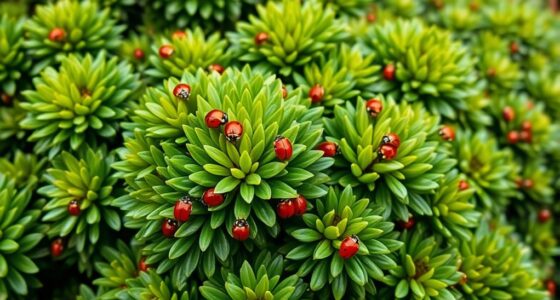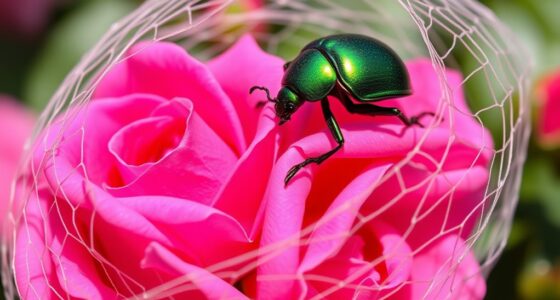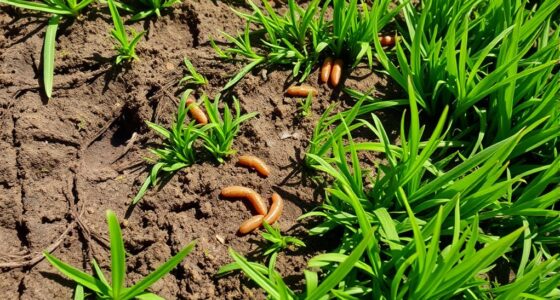To distinguish chinch bug damage from drought stress, look for visual signs like small insects or frayed grass edges, especially near turf bases or mulch beds. Check soil moisture and grassy patches; chinch bugs often cause irregular, localized browning, while drought stress typically affects large, uniform areas. Inspect the grass and soil carefully for pests. Understanding these patterns helps you identify the issue—keep exploring for more tips on effective diagnosis.
Key Takeaways
- Look for irregular, localized patches with tiny black insects on grass blades to identify chinch bug damage versus uniform drought browning.
- Check soil moisture and turf response; improvement after watering suggests drought stress, while persistent damage indicates chinch bugs.
- Inspect damaged areas closely for chinch bugs on grass blades or soil surface, especially near turf base or mulch beds.
- Note the pattern of browning: widespread, uniform browning points to drought, while patchy, uneven areas suggest pest activity.
- Use targeted insect control for chinch bugs and deep watering plus soil health practices for drought stress to effectively manage each issue.
Recognizing the Visual Signs of Damage
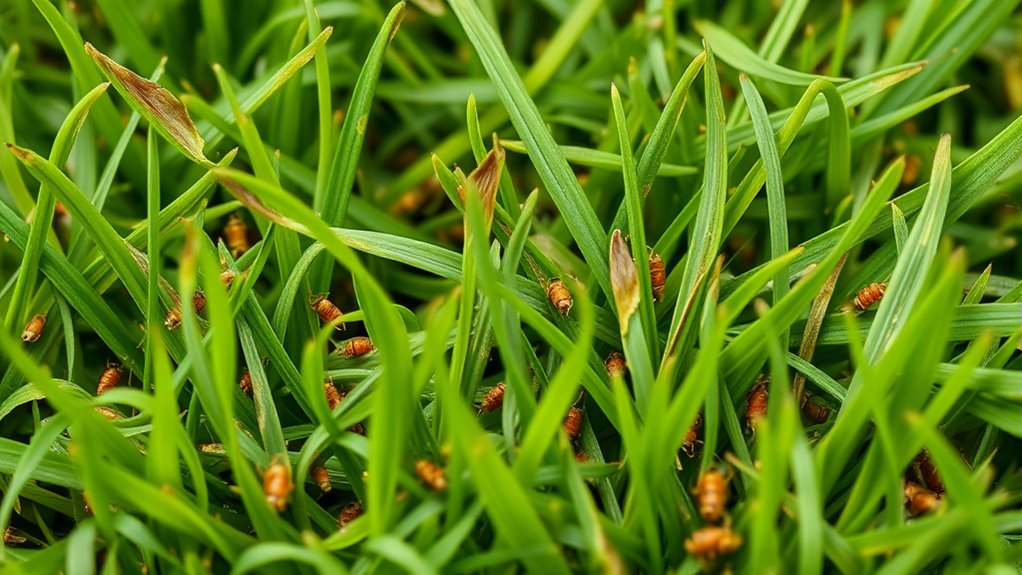
To identify chinch bug damage on your turf, start by closely inspecting the grass for telltale signs. Look for areas that appear wilted, yellowed, or brown, especially in patches that seem to dry out quickly. These pests feed on grass blades and roots, causing the grass to weaken and die off, which can be mistaken for drought stress. Recognizing these visual cues is essential for effective pest control and proper drought management. Check for small, dark insects or their excrement at the base of damaged grass patches. If you notice these symptoms, act promptly to prevent further damage. Early detection allows you to implement targeted pest control measures, saving your lawn from extensive damage while distinguishing pest issues from natural drought effects. Additionally, understanding the turf stress factors can help differentiate between pest damage and environmental conditions affecting your lawn.
Examining the Grass and Soil Conditions

When examining your lawn, paying close attention to both grass and soil conditions can reveal essential clues about the underlying issue. Start by inspecting the grass’s color, texture, and overall health; dull, brown patches may indicate stress or pest activity. Next, test the soil through soil testing to determine pH levels and moisture content. Conduct nutrient analysis to identify deficiencies that could weaken the grass, making it more vulnerable to pests or drought stress. Check for compacted soil, which restricts roots and water movement. Healthy soil supports vigorous grass growth, while poor soil conditions often exacerbate turf problems. Additionally, understanding the specific Volkswagen Tuning techniques can help you better manage soil and turf health if you’re using modified equipment or systems in your landscape maintenance. By combining visual inspection with soil testing and nutrient analysis, you can better diagnose whether chinch bugs, drought stress, or a combination of factors is affecting your lawn.
Conducting a Simple Inspection for Chinch Bugs

Start by looking closely at your turf for any signs of damage, like wilting or discolored patches. Next, check the grass blades and soil surface for chinch bugs or their shed skins. If you spot insects or suspect an infestation, it’s time to do a thorough insect presence check. Monitoring for pest activity is essential, especially since integrated pest management strategies can help control chinch bugs effectively.
Visual Damage Signs
Performing a simple inspection is the most effective way to identify chinch bug activity in your turf. Look for visual damage signs that indicate pest presence or drought stress. Common signs include:
- Irregular patches of yellowing or browning grass
- Wilting or dead turf areas that don’t recover with watering
- Tiny black or gray insects visible on grass blades or stems
- Frayed or chewed grass edges, often near the soil surface
These signs can help distinguish chinch bug damage from drought stress. Regular visual checks are essential for pest management. If you notice damage, consider soil testing to confirm pest activity and assess soil health, leading to targeted treatments. Early detection minimizes damage and keeps your turf healthy. Monitoring AI safety measures can also help prevent unforeseen issues impacting your turf management practices.
Insect Presence Check
To effectively detect chinch bugs in your turf, you need to conduct a simple insect presence check. Begin by inspecting the affected areas closely, looking for signs of pest activity. Gently lift sections of turf or thatch and look for chinch bugs on the grass blades, especially near the soil surface. Pay attention to areas showing drought stress symptoms, as chinch bugs often hide there. Conduct a soil analysis by disturbing the soil slightly and observing if chinch bugs emerge or move. Accurate pest identification is vital; compare any insects found to images of chinch bugs. This simple check helps determine if pests are contributing to turf damage, guiding you toward appropriate treatment options. Regular inspections ensure early detection and better turf recovery.
Observing the Pattern and Location of Browning
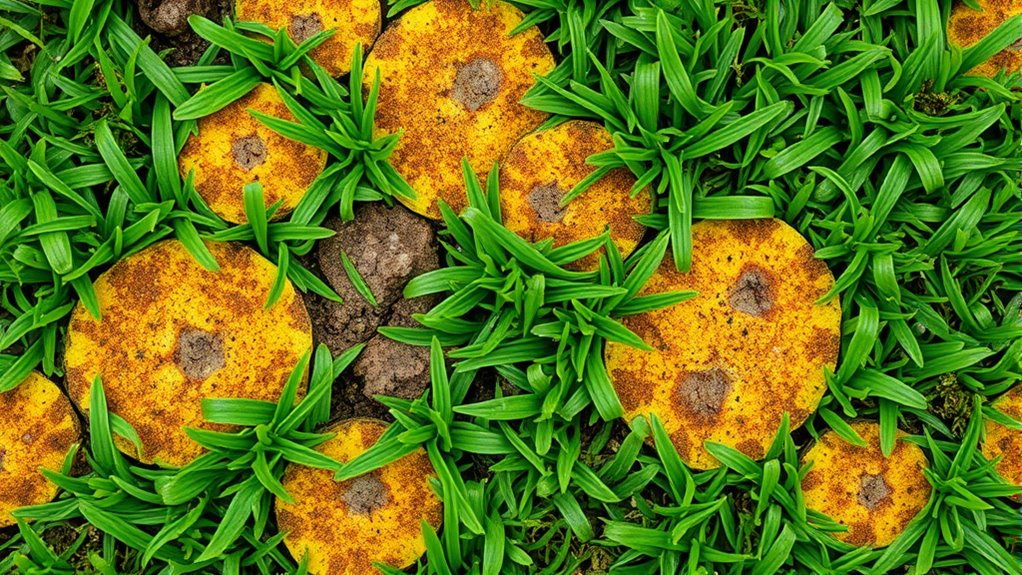
Pay attention to how the browning spreads across your turf; different patterns can indicate specific issues. Notice which zones are affected first—whether it’s the edges, center, or random patches. This information helps you identify whether chinch bugs or drought stress are causing the problem. Recognizing early signs of turf damage can facilitate prompt and effective treatment.
Browning Distribution Patterns
Understanding the pattern and location of browning is essential for distinguishing between chinch bug damage and drought stress. Chinch bugs tend to cause irregular or localized patches, often starting at the edges of the turf and moving inward. In contrast, drought symptoms usually appear as uniform browning across large areas. To identify pest damage, look for these clues:
- Browning in irregular patches rather than even coverage
- Damage starting near the base of turf blades or mulch beds
- Presence of chinch bugs upon close inspection
- Drought symptoms showing as widespread, uniform browning
Recognizing these browning distribution patterns helps you correctly diagnose pest identification issues versus drought stress, ensuring you take appropriate action quickly.
Affected Turf Zones
Examining where browning occurs on your turf reveals important clues about the underlying problem. If browning is confined to specific, irregular patches, it may indicate pest management issues like chinch bugs, which often target certain zones. In contrast, drought stress tends to cause uniform browning across larger areas, especially in exposed sections with poor water retention. Pay attention to whether the damage is localized or widespread; localized browning suggests pest activity, while widespread browning points to drought conditions. Understanding this pattern helps you determine the best course of action—whether to focus on pest management strategies or implement drought mitigation techniques. Observing affected turf zones closely allows you to diagnose the problem accurately and take targeted steps to restore healthy turf. Additionally, recognizing signs of industry transformation can provide innovative solutions for turf health management.
Assessing Watering History and Soil Moisture

To accurately diagnose turf issues, you need to evaluate both your watering history and soil moisture levels. Consistent irrigation scheduling helps prevent drought stress, but overwatering can also harm your lawn. Checking soil moisture involves soil testing to determine if the roots are getting enough water. Look for signs like dry patches or overly wet areas. Keep these points in mind:
- Track your irrigation times and amounts
- Use soil testing tools to check moisture levels
- Avoid watering on a fixed schedule without adjusting for weather
- Monitor turf appearance regularly for stress signs
- Understanding projector technology can help you better assess environmental factors affecting your lawn’s health.
Maintaining proper soil moisture is key to avoiding drought stress and preventing chinch bugs from thriving. Proper assessment of watering habits ensures your lawn remains healthy and resilient.
Comparing Response to Watering and Pest Control
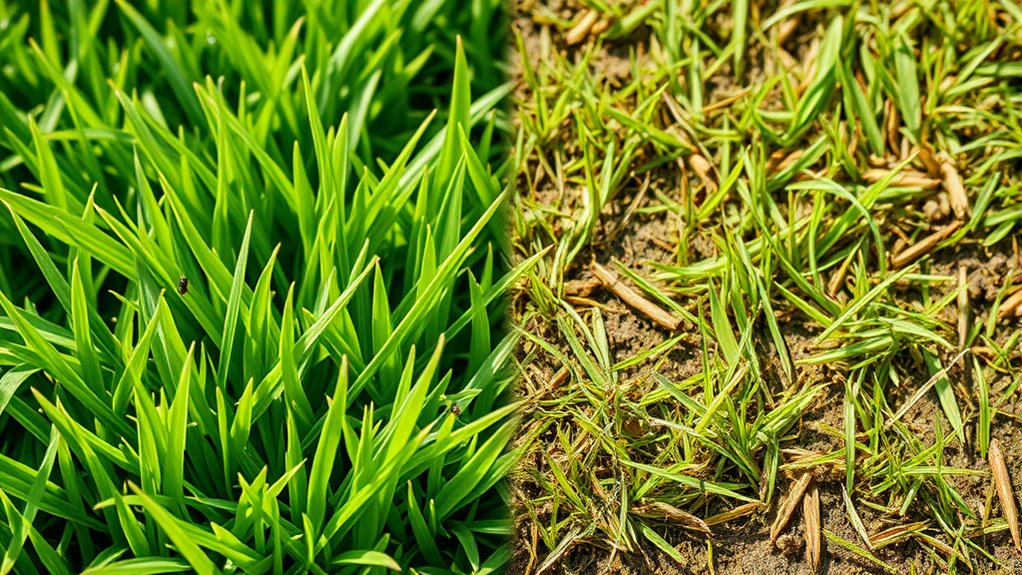
How your lawn responds to watering differs markedly from its reaction to pest control measures like chinch bug management. Proper watering practices help alleviate drought stress by promoting healthy root growth and restoring moisture levels. If your turf improves with increased watering, drought stress is likely the culprit. In contrast, pest management targets specific pests; chinch bugs cause localized damage that doesn’t improve just with watering. If your grass shows minimal change despite adjusted watering, pests may be involved. Recognizing this distinction is vital for effective treatment. While watering can resolve drought issues, pest management involves targeted treatments to eliminate chinch bugs. Understanding lawn responses allows you to diagnose your lawn’s problems accurately and choose the appropriate approach.
Implementing Corrective Measures Based on Diagnosis
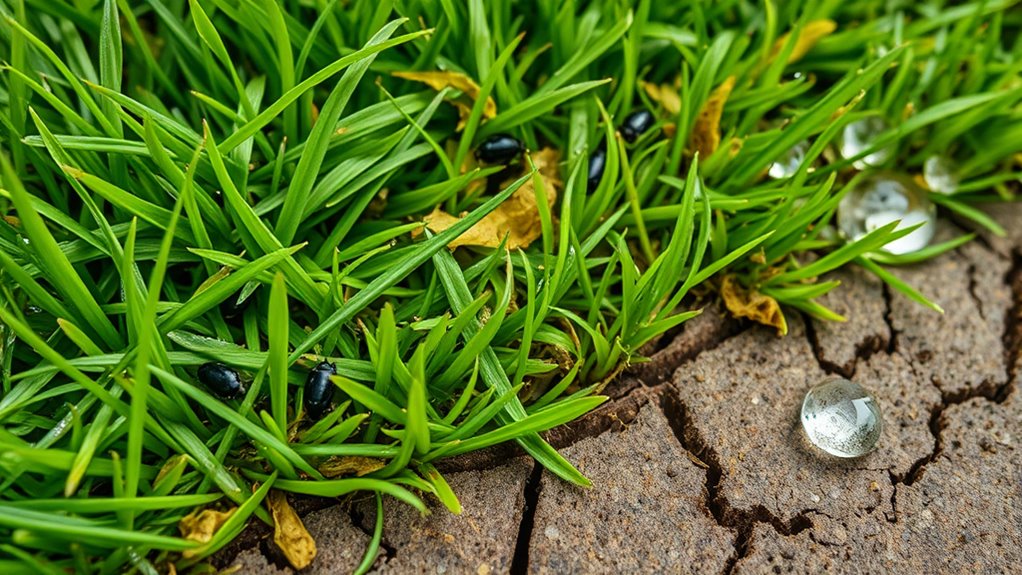
Once you’ve identified whether drought stress or chinch bugs are affecting your lawn, implementing the appropriate corrective measures becomes essential. For drought stress, focus on drought mitigation strategies such as deep watering and improving soil health to retain moisture. If chinch bugs are the issue, pest management involves targeted insecticides and natural predators. To effectively address these problems, consider these steps:
Identify the issue—drought or chinch bugs—and take targeted actions like deep watering or pest control for a healthy lawn.
- Adjust watering practices to provide deep, infrequent soakings
- Apply appropriate pest control treatments for chinch bugs
- Aerate and fertilize to strengthen turf resilience
- Monitor closely to prevent recurrence
- Incorporate Kia Tuning techniques to optimize lawn maintenance tools and practices for better results
Frequently Asked Questions
How Can I Distinguish Between Drought Stress and Pest Damage Visually?
You can distinguish drought stress from pest damage by observing visual cues and color changes. Drought stress typically causes the grass to turn a dull, bluish-gray or grayish-green, and the turf may appear thin or wilted. Pest damage, like chinch bugs, often results in irregular patches with dead or brown spots, and you might notice tiny insects or their debris. Carefully examine the affected areas for these visual clues to identify the problem.
Are There Specific Turfgrass Types More Susceptible to Chinch Bugs?
Some turfgrass types are more susceptible to chinch bugs due to their pest predisposition, especially warm-season grasses like St. Augustine, centipede, and zoysia. You should pay close attention to these varieties, as their susceptibility makes them prime targets for infestations. Recognizing these vulnerabilities helps you implement early prevention strategies, ensuring your lawn stays healthy and resilient against chinch bug damage.
What Time of Day Is Best for Inspecting for Chinch Bugs?
You might find that inspecting for chinch bugs is most effective during the early morning or late afternoon, when pest activity peaks due to cooler temperatures and increased movement. Coincidentally, these times also allow you to spot signs of damage more clearly. Accurate inspection timing helps you catch infestations early, making pest activity easier to observe and manage. So, schedule your inspections during these key periods for the best results.
Can Environmental Factors Like Shade Influence Damage Appearance?
Shade impact can markedly influence damage appearance on your turf. In shaded areas, soil moisture tends to stay higher, which may reduce drought stress symptoms but can also hide chinch bug activity. This makes it harder to spot damage early. You should regularly check shaded spots, as the moisture can mask issues, and chinch bugs might still be causing damage even if the turf looks relatively healthy.
How Often Should I Monitor My Turf for Early Signs of Pests or Drought?
Think of your turf as a delicate garden that needs constant care. You should monitor your turf weekly during peak growing seasons and at least bi-weekly during slower months. Regular turf health monitoring helps catch early signs of pests or drought. Incorporate pest prevention strategies like proper watering, mowing, and aeration to keep your lawn resilient. Staying vigilant guarantees your grass remains lush and healthy, avoiding costly repairs later.
Conclusion
By carefully observing the signs on your turf, you’ll untangle whether chinch bugs or drought stress cause the damage. Think of your lawn as a patient needing a thorough check-up; each clue guides your diagnosis. When you act promptly and correctly, you’re like a skilled detective solving a turf mystery. Addressing the issue today guarantees your grass regains its vibrant health, turning your yard from a suffering patient to a lush, thriving oasis.



